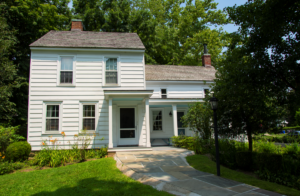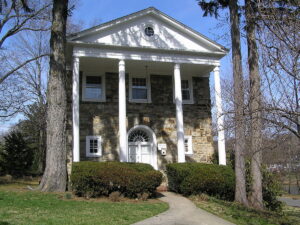Every so often, I leave my New To Seattle venue to visit some place else. I am writing this in New Rochelle, N.Y., not because it has New in its name–that’s strictly a coincidence–but because I have in-laws here. As it happens, they live in a New York City suburb very near a shrine to the man whose writings are credited with triggering the big event that happened 236 years ago this very week on July 4, 1776.
But I have to tell you, from the standpoint of historical geography it ain’t much of a shrine. That’s because nothing of real significance happened there.
I am referring to the Thomas Paine Cottage, which I visited for the first time this week after passing by it for decades. It’s perhaps the last tangible vestige of the English philosopher and revolutionary (1737-1809) who came to America in late 1774 and within 14 months published “Common Sense.” That was the best-selling manifesto for freedom so persuasive and fiery the Second Continental Congress borrowed large chunks of its logic when fashioning the Declaration of Independence just a few months later.
Why am I so down on this tribute to a man listed among the country’s Founding Fathers? Let me list some reasons:
–Paine didn’t write “Common Sense” at the cottage. He authored it in Philadelphia, 100 miles to the south. Nor did he write at the cottage his other famous works, which included “The Age of Reason,” “Rights of Man” and “Agrarian Justice.”
–Because he also was fomenting the later revolution in France–where he almost lost his own head–Paine lived in the cottage for only four years, a residency that didn’t even start until more than a quarter-century after he wrote “Common Sense.” So the cottage was basically a retirement pad. And a part-time one at best. In his later years Paine also maintained a home in New York City’s Greenwich Village, which is where he died in 1809.
–The location of the cottage is not all that historically accurate. At the time the house, rebuilt after a fire, was located a quarter-mile away up a hill. It was moved to its present location in 1908–99 years after Paine’s death–so a real-estate developer could start developing the area with stately homes that still exist.
–The contents of the cottage include exactly three historical items with any real connection to Paine: two chairs he sat in and a Franklin stove given to him by its inventor, Benjamin Franklin, who was also his patron. That’s all, folks. The rest of the holdings are largely period nick-knacks.
–A marker installed in 1952 accurately notes the spot where Paine was buried a few yards from where the cottage now stands. But what the marker’s inscription doesn’t say is that 10 years after Paine’s death, a crazy London journalist in 1819 secretly dug up his bones and shipped them back to England, where they were eventually lost to history. In 2009 the heist made a Time Magazine list of “Top 10 Famous Stolen Body Parts,” along with Geronimo’s skull and Napoleon’s, uh, junk.
–The two-story cottage itself is a little ratty, no doubt due to strained financial resources of its owner, the Huguenot & New Rochelle Historical Society (Huguenots were French Protestants who left France in the face of religious persecution; they founded New Rochelle in 1688.) The facility is only open three days a week. Last year, just 2,300 visitors dropped by, according to John R. Wright, the cottage’s genial director, who kindly showed me around and patiently answered my pointed questions. I paid the suggested $5 donation.
The Paine Cottage sits on an edge of the 277-acre parcel that the New York Legislature gave Paine in 1784 in recognition of his service to the Revolution. Given Paine’s fame as a exponent of individual freedom, the circumstances have to be regarded as a little questionable: The land and the cottage had been seized years earlier from a supporter of King George III.
I find the real estate connection utterly underwhelming, even with a nearby marble monument to Paine erected in 1839 topped by a bronze bust added in 1905. But that same marketplace of ideas nurtured by Paine has produced in New Rochelle what I regard as a delicious irony: competing Paine nonprofits hurling invective at each other, in the fashion of the Great Man himself.
About 90 yards from the Cottage along North Avenue on the other side of the monument sits a grand edifice with a sign declaring it the Thomas Paine Museum. It’s the property of the rival Thomas Paine National Historical Association, founded in 1884. The stone building, erected in 1925 amid much fanfare (inventor Thomas A. Edison wielded the groundbreaking shovel), once held genuine Paine artifacts and was a respected resource for serious Paine scholars.
But the museum has been shut for years following scandalous allegations it sold off key holdings and cut too sweet a deal for its director. Under pressure from state charitable regulators, much of its contents has been transferred to the library at nearby Iona College. The Paine Museum’s main exhibit room is almost completely empty, as I saw when I peered through a window today. However, a contract gardener who happened to be trimming the grounds around the building told me its interior is being spruced up and that a reopening is planned for September.
Two years ago, the Huguenots with their cottage gave a “Spirit of Thomas Paine” award to Dick Morris, the Democrat-turned-Republican political operative and pundit. The Paine Museum, which used to issue its own annual award, promptly issued a press release mocking its rival’s understanding of Paine’s political philosophy, which included encouragement of progressive taxation and disparagement of organized religion, not exactly mainstays of current Republican thought. “The Huguenots should look after the history of the Huguenots,” the snarky statement said.
Over at the cottage, director Wright said the Paine Museum conducts fundraising by trying to fool people into thinking it owns the cottage. “It is absolutely misrepresenting itself,” he told me, quickly recounting his enemy’s now-checkered history.
In “Common Sense,” Paine wrote, “Suspicion is the companion of mean souls, and the bane of all good society.” As I head back to Seattle, that strikes me as the best take-away–for all the wrong reasons–from Paine’s unmemorable but oddly evocative brief stay in New Rochelle.
Follow William P. Barrett’s work on Twitter by clicking here.
Share on Facebook


